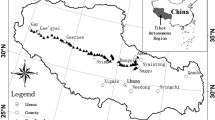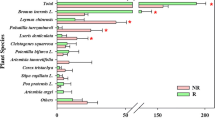Abstract
Purpose
It has been suggested that above and belowground interactions produce important feedbacks in natural ecosystems. It is necessary to study the relationships between aboveground plant functional group traits and belowground biomass and soil chemical properties in natural grasslands.
Materials and methods
In a field study, four natural alpine meadows dominated by different plant functional groups were selected. We assigned the plant species to one of two functional groups: the grasses functional group (GFG) or the forbs functional group (FFG). The aboveground GFG and FFG biomass and total belowground biomass were measured. At the same time, for each sampling quadrat, soil pH, soil organic matter (SOM), total nitrogen (TN), available nitrogen (AN), total phosphorus (TP), and available phosphorus (AP) were determined.
Results and discussion
GFG-dominated meadows had significantly higher total belowground biomass, SOM, TN, TP, AN, and AP than FFG-dominated meadows. Correlation analyses showed that total belowground biomass (to a depth of 30 cm) and soil nutrient contents were significantly and positively correlated with the GFG biomass proportion, but negatively correlated with the FFG biomass proportion.
Conclusions
There were significant positive correlations among above and belowground biomass and the soil chemical properties studied. The GFG proportion may thus be an indicator of soil chemical properties in the studied meadow types. This implies that natural increases in, or introduction of more, GFG species in FFG-dominated meadows may improve soil nutrient conditions. This study provides the basis of understanding for future studies on plant–soil interactions and feedbacks in grassland ecosystems.



Similar content being viewed by others
References
Aerts R, Chapin FSIII (2000) The mineral nutrition of wild plants revisited: a re-evaluation of processes and patterns. Adv Ecol Res 30:1–67
Agriculture Chemistry Council, Soil Science Society of China (1983) General analysis methods of soil agriculture chemistry. Science Press, Beijing
Bardgett RD, Wardle D (2003) Herbivore-mediated linkages between aboveground and belowground communities. Ecology 84:2258–2268
Bardgett RD, Bowman WD, Kaufmann R, Schmidt SK (2005) A temporal approach to linking aboveground and belowground ecology. Trend Ecol Evol 20:634–641
Bever JD (1994) Feedback between plants and their soil communities in an old field community. Ecology 75:1965–1977
Bezemer TM, Lawson CS, Hedlund K, Edwards AR, Brook AJ, Igual JM, Mortimer SR, van der Putten WH (2006) Plant species and functional group effects on abiotic and microbial soil properties and plant–soil feedback responses in two grasslands. J Ecol 94:893–904
Casper BB, Castelli JP (2007) Evaluating plant–soil feedback together with competition in a serpentine grassland. Ecol Lett 10:394–400
De Deyn GB, Van der Putten WH (2005) Linking aboveground and belowground diversity. Trend Ecol Evol 20:625–633
De Ruiter PC (2002) Ecosystem structures above- and belowground. Book review of communities and ecosystems: linking the aboveground and belowground components (D.A. Wardle, Princeton University Press). Trend Ecol Evol 17:584–585
Distel RA, Boo RM (1996) Vegetation states and transitions in temperate semiarid rangelands of Argentina. In: West NE (ed) Rangelands in a sustainable biosphere. Society for Range Management, Denver, pp 117–118
Ebersberger D, Niklaus PA, Kandeler E (2003) Long term CO2 enrichment stimulates N-mineralisation and enzyme activities in calcareous grassland. Soil Bio Biochem 35:965–972
Ettema CH, Wardle DA (2002) Spatial soil ecology. Trend Ecol Evol 17:177–183
Eviner VT (2004) Plant traits that influence ecosystem processes vary independently among species. Ecology 85:2215–2229
Gastine A, Scherer-Lorenzen M, Leadley PW (2003) No consistent effects of plant diversity on root biomass, soil biota and soil abiotic conditions in temperate grassland communities. Appl Soil Ecol 24:101–111
Gordon WS, Jackson RB (2000) Nutrient concentrations in fine roots. Ecology 81:275–280
Haase J, Moretto AS, Distel RA, Boutton TW, Boo RM (2008) Above-belowground interactions are mediated by nutrient availability. Ecology 89:3072–3081
Harris WN, Wren IF, Herman DJ, Firestone MK (2007) Fire and grazing in grasslands of the Argentine Caldenal: effects on plant and soil carbon and nitrogen. Acta Oecol 32:207–214
Hawkes CV, Wren IF, Herman DJ, Firestone MK (2005) Plant invasion alters nitrogen cycling by modifying the soil nitrifying community. Ecol Lett 8:876–985
Hobbie SE (1992) Effects of plant species on nutrient cycling. Trend Ecol Evol 7:336–339
Huston MA (1996) Biological diversity: the coexistence of species on changing landscapes. Cambridge University Press, New York, p 681
Johnson LC, Matchett JR (2001) Fire and grazing regulate belowground processes in tallgrass prairie. Ecology 82:3377–3389
Kardol P, Bezemer TM, van der Putten WH (2006) Temporal variation in plant–soil feedback controls succession. Ecol Lett 9:1–9
Lavorel S, Garnier E (2002) Predicting changes in community composition and ecosystem functioning from plant traits: revisiting the Holy Grail. Funct Ecol 16:545–556
McLaren JR (2006) Effects of plant functional groups on vegetation dynamics and ecosystem properties. Infor North 59:449–451
McLaren JR (2008) Effects of plant functional group loss on soil chemical properties in a northern grassland. The 93rd ESA Annual Meeting (August), COS 84 Ecosystem Function: Biodiversity II-3
Mengel K (1996) Turnover of organic nitrogen in soils and its availability to crops. Plant Soil 181:83–93
Moretto AS, Distel RA (1997) Competitive interactions between palatable and unpalatable grasses native to a temperate semiarid grassland of Argentina. Plant Ecol 130:155–161
Moretto AS, Distel RA (2002) Soil nitrogen availability under grasses of different palatability in a temperate semiarid rangeland of central Argentina. Austral Ecol 27:509–514
Moretto AS, Distel RA, Didone NE (2001) Decomposition and nutrient dynamic of leaf litter and roots from palatable and unpalatable grasses in a semi-arid grassland. Appl Soil Ecol 18:31–37
Peralta AL, Wander MM (2008) Soil organic matter dynamics under soybean exposed to elevated CO2. Plant Soil 303:69–81
Robertson GP, Gross KL (1994) Assessing the heterogeneity of belowground resources: quantifying pattern and scale. In: Caldwell MM, Pearcy RW (eds) Exploitation of environmental heterogeneity by plants: ecophysiological processes above- and belowground. Academic Press, San Diego, pp 237–253
Šmilauerová M, Šmilauer P (2006) Co-occurring graminoid and forb species do not differ in their root morphological response to soil heterogeneity. Folia Geobot 41:121–135
Van der Putten WH, Vet LEM, Harvey JA, Wackers FL (2001) Linking above- and belowground multitrophic interactions of plants, herbivores, pathogens, and their antagonists. Trend Ecol Evol 16:547–554
Van der Wal R, Bardgett RD, Harrison KA, Stien A (2004) Vertebrate herbivores and ecosystem control: cascading effects on tundra ecosystems. Ecography 27:242–252
Wang CT, Cao GM, Wang QL, Jing ZC, Ding LM, Long RJ (2007) Research on variation of species composition and biomass along environmental gradient of plant community in alpine meadow of the Qinghai–Tibetan Plateau. Sci China C Life Sci 37:585–592
Wardle DA, Zackrisson O (2005) Effects of species and functional group loss on island ecosystem properties. Nature 435:806–810
Wu GL, Du GZ, Liu ZH, Thirgood S (2009) Effect of fencing and grazing on a Kobresia-dominated meadow in the Qinghai–Tibetan Plateau. Plant Soil 319:115–126
Wu GL, Liu ZH, Zhang L, Cheng JM, Hu TM (2010a) Long-term fencing improved soil properties and soil organic carbon storage in an alpine swamp meadow of western China. Plant Soil 332:331–337
Wu GL, Liu ZH, Zhang L, Hu TM, Cheng JM (2010b) Effects of artificial grassland establishment on soil nutrients and carbon properties in a black-soil-type degraded grassland. Plant Soil 333:469–479
Acknowledgments
The authors thank Robert M. Rees, Wim van der Putten, Nicholas B. Comerford, Kimberly Y. Epps, and two anonymous reviewers for their valuable comments and suggestions, and David Warrington for improving the English writing of the manuscript. We also thank Liu Zhen-Heng and other colleagues of the Maqu Grassland Station for their assistance in field investigation and soil sampling. This work is supported by the Strategic-leader Sci-Tech Projects of Chinese Academy of Sciences (XDA05050403), the “100-Talent Program” of Chinese Academy of Sciences, and the Open Funds of the State Key Laboratory of Soil Erosion and Dryland Farming on the Loess Plateau China (10502-Z8-5, Z12).
Author information
Authors and Affiliations
Corresponding authors
Additional information
Responsible editor: Winfried Schröder
Rights and permissions
About this article
Cite this article
Wu, GL., Li, W., Shi, ZH. et al. Aboveground dominant functional group predicts belowground properties in an alpine grassland community of western China. J Soils Sediments 11, 1011–1019 (2011). https://doi.org/10.1007/s11368-011-0367-y
Received:
Accepted:
Published:
Issue Date:
DOI: https://doi.org/10.1007/s11368-011-0367-y




